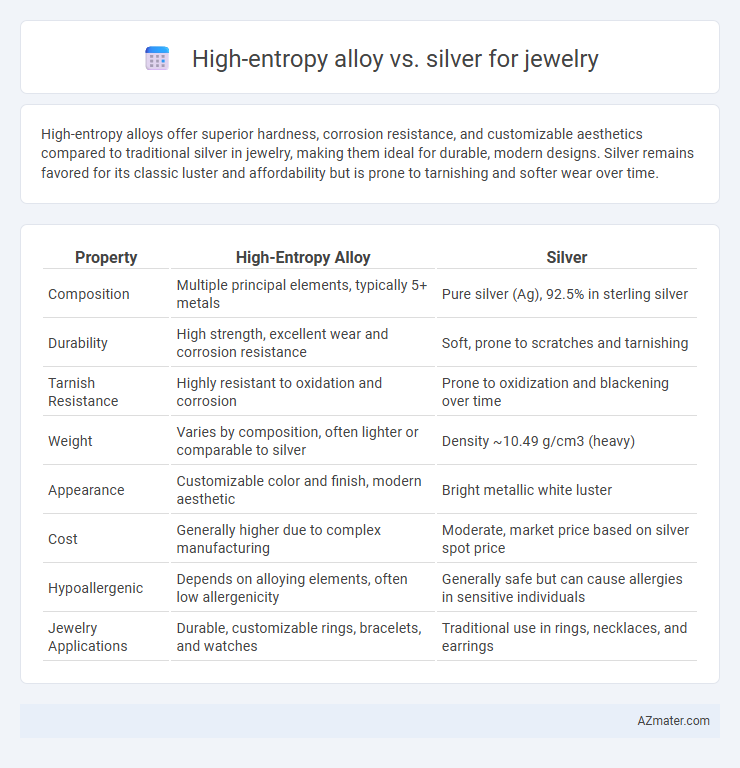High-entropy alloys offer superior hardness, corrosion resistance, and customizable aesthetics compared to traditional silver in jewelry, making them ideal for durable, modern designs. Silver remains favored for its classic luster and affordability but is prone to tarnishing and softer wear over time.
Table of Comparison
| Property | High-Entropy Alloy | Silver |
|---|---|---|
| Composition | Multiple principal elements, typically 5+ metals | Pure silver (Ag), 92.5% in sterling silver |
| Durability | High strength, excellent wear and corrosion resistance | Soft, prone to scratches and tarnishing |
| Tarnish Resistance | Highly resistant to oxidation and corrosion | Prone to oxidization and blackening over time |
| Weight | Varies by composition, often lighter or comparable to silver | Density ~10.49 g/cm3 (heavy) |
| Appearance | Customizable color and finish, modern aesthetic | Bright metallic white luster |
| Cost | Generally higher due to complex manufacturing | Moderate, market price based on silver spot price |
| Hypoallergenic | Depends on alloying elements, often low allergenicity | Generally safe but can cause allergies in sensitive individuals |
| Jewelry Applications | Durable, customizable rings, bracelets, and watches | Traditional use in rings, necklaces, and earrings |
Introduction: High-Entropy Alloys vs. Silver in Jewelry
High-entropy alloys (HEAs) offer unparalleled strength, corrosion resistance, and unique multi-metal compositions compared to traditional silver used in jewelry. Silver, valued for its luster and malleability, lacks the enhanced durability and oxidation resistance found in HEAs, making HEAs increasingly preferred in modern, high-performance jewelry designs. The growing demand for longer-lasting, scratch-resistant pieces positions high-entropy alloys as a revolutionary alternative to conventional silver in the jewelry industry.
Composition and Material Structure
High-entropy alloys (HEAs) consist of five or more principal elements mixed in near-equal atomic percentages, creating a complex, multi-component structure with superior mechanical properties and corrosion resistance compared to traditional metals like silver. Silver is primarily composed of 99.9% pure silver atoms arranged in a face-centered cubic (FCC) crystalline structure, providing excellent ductility, electrical conductivity, and a hallmark lustrous finish. The multi-elemental, solid-solution reinforced microstructure of HEAs offers enhanced hardness and wear resistance, making them potentially more durable than silver for jewelry applications.
Aesthetic Appeal: Color and Finish
High-entropy alloys offer a unique aesthetic appeal with customizable color options ranging from matte metallic hues to vibrant iridescence, achieved through varied elemental combinations and surface treatments. Silver, prized for its bright, lustrous white finish, develops a distinctive patina over time, enhancing its classic elegance and vintage charm. Both materials provide versatile finishes, but high-entropy alloys enable more experimental and durable aesthetics compared to traditional silver jewelry.
Strength and Durability Comparison
High-entropy alloys (HEAs) exhibit superior strength and durability compared to traditional silver used in jewelry, due to their multi-element composition that enhances hardness and resistance to wear and corrosion. Silver, while valued for its aesthetic appeal and malleability, is relatively soft with a Mohs hardness of about 2.5 to 3, making it more prone to scratches and deformation. HEAs offer improved mechanical properties, making them ideal for jewelry that demands long-lasting structural integrity and minimal maintenance.
Corrosion and Tarnish Resistance
High-entropy alloys exhibit superior corrosion and tarnish resistance compared to silver, making them highly suitable for long-lasting jewelry applications. These alloys form stable passive oxide layers that prevent surface degradation even in harsh environments, whereas silver tarnishes quickly due to sulfur compounds in the air. Their enhanced durability reduces the need for frequent cleaning and maintenance, offering a more resilient jewelry option.
Weight and Comfort for Wearers
High-entropy alloys typically offer greater strength with reduced density compared to silver, resulting in lighter jewelry pieces that enhance wearer comfort. Silver, while denser and heavier, provides a traditional feel but may contribute to fatigue during extended wear. The lightweight nature of high-entropy alloys minimizes skin pressure and allows for prolonged use without discomfort, making them advantageous for daily wear jewelry.
Hypoallergenic Properties and Skin Sensitivity
High-entropy alloys (HEAs) exhibit superior hypoallergenic properties compared to traditional silver, reducing the risk of skin irritation and allergic reactions. Unlike silver, which can tarnish and sometimes cause sensitivity due to nickel or other alloyed metals, HEAs are engineered with biocompatible elements that enhance skin comfort and durability. This makes high-entropy alloys an ideal choice for individuals with sensitive skin seeking durable, hypoallergenic jewelry options.
Workability and Design Flexibility
High-entropy alloys (HEAs) offer superior workability compared to traditional silver, exhibiting enhanced hardness and wear resistance while maintaining adequate malleability for intricate shaping. These alloys enable greater design flexibility by allowing the incorporation of multiple elements that tailor mechanical properties and color variations, surpassing silver's relatively limited adaptability. Silver, known for its softness and ease of casting, is prone to deformation and tarnishing, making HEAs a more durable and versatile choice for contemporary jewelry design.
Cost and Market Availability
High-entropy alloys (HEAs) generally present a higher production cost compared to silver due to their complex manufacturing processes and use of multiple costly elements like nickel, cobalt, and chromium. Silver remains more affordable and widely available, benefiting from established supply chains and large-scale mining operations globally. Market availability for HEAs in jewelry is limited and niche, whereas silver dominates with extensive retail presence and consumer familiarity.
Sustainability and Environmental Impact
High-entropy alloys (HEAs) offer increased sustainability over traditional silver in jewelry due to their enhanced durability, reducing the need for frequent replacement and minimizing resource consumption. Unlike silver mining, which involves significant environmental degradation and toxic chemical use, HEA production can incorporate recycled metals and requires less intensive extraction processes. This shift towards HEAs supports environmentally responsible jewelry manufacturing by lowering carbon footprints and promoting material efficiency.

Infographic: High-entropy alloy vs Silver for Jewelry
 azmater.com
azmater.com